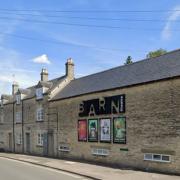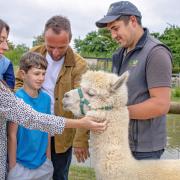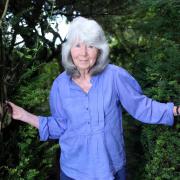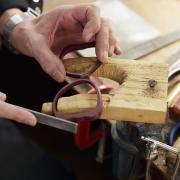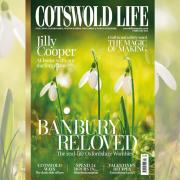Bristol artist Luke Jerram is returning to the city of Gloucester this month with an exciting new community exhibition

Earlier this year, Gloucester Culture Trust reached out to the residents of Gloucestershire to be part of an exciting art installation coming to Gloucester at the end of August. Individuals, groups and organisations from across the county were invited to write a sentence, phrase or poem to be submitted as part of Luke Jerram’s latest community exhibition, Of Earth and Sky.
Residents and visitors to the city in recent years will know Luke’s work well, as the Bristol-based artist is the creator of Museum of the Moon, an astonishing seven-metre in diameter internally-lit sphere using NASA imagery of the lunar surface. The sculpture came to Gloucester Cathedral in October 2019, and visitors flocked to experience the beautiful and surreal sight of the moon, that seemed to have ventured down from the night sky to take up temporary residence in the cavernous nave.
Luke was at the launch event himself, and seemed slightly bemused by the gasps of astonishment his work invoked in the gathered crowd. For his works, from a 90-foot-long E.coli sculpture to a giant aeolian harp, and a plant orchestra at Cambridge Botanical Gardens to political projections above Bristol, have been stopping us in our tracks for some years now.
“I was the sort of kid who would take apart radios and televisions to try and work out what was going on inside,” he says, “but they’d never go back together properly and work again afterwards. But that was the nature of it, really. I have a curious mind.”

Luke has never lost his curiosity, and is fascinated by how we all view life so very differently.
“I have an interest in visual perception,” he continues, “which affects the questions that I ask as an artist and has informed a number of the artworks I’ve made over the years.
“I do think about how an artwork will be interpreted by the public; it’s very important. I try to create pieces that can be appreciated on different levels and so an academic may read it one way, and a four-year-old may see it very differently. I also try to leave space for other people to be creative; for me, that’s quite exciting. Pieces like Park and Slide [a bonkers 300-foot water slide down Bristol’s Park Street], the street pianos [Play Me I’m Yours] and Of Earth and Sky mean there’s an opportunity for the public to be creative and for there to be unknown possibilities.”
Originally from Randwick in Gloucestershire, Luke went on to study at Cheltenham and then Cardiff, before moving to Bristol. He now has his offices at the very funky Bristol Paintworks, a creative hub near Arnos Vale. He also happens to be red/green colour-blind though, apart from it making him “crap” at painting (I don’t believe him), it’s far from being a disability.

“They used colourblind people in the Second World War to detect camouflage vehicles,” he says, “as we have a better sense of texture and form. Also, some colourblind people have slightly better night vision, so there are some benefits.
“I’m aware that everyone sees the world differently. When we arrive at an artwork, we carry our memories and knowledge with us, and that informs our interpretation of it.”
Another of his brilliant series studies the global impact of viruses. The transparent Glass Microbiology sculptures provide an alternative to the usually luridly-coloured images we see printed in newspapers (“viruses don’t actually have colour as they’re smaller than the wavelength of light”) and they’re beautiful objects in their own right, again challenging our perceptions of something generally seen as being so destructive. Photographs of these pieces, which include malaria, HIV, swine flu and Covid-19, are now used in medical books and documents to help illustrate what viruses actually look like. Beautiful and functional.
Another of Luke’s thought-provoking pieces is Withdrawn, which features several abandoned boats in woodland, and is his response to the issue of flooding. A hauntingly beautiful piece, created in collaboration with the National Trust, it became a location for events, brought alive with music and actors performing plays on site. And afterwards, all the boats became play equipment for schools. “The legacy for the artworks is very important,” he states.

Lockdown for Luke has, he says, been “a bit shit”, with exhibitions being cancelled or postponed.
As a response to the pandemic, though, he’s created an art project called In Memorium, to be presented in Antwerp and then to tour parks and cities around the UK. It’s a striking piece made up of many flags created from bed sheets, and is a tribute to those who have died, and to NHS and other key workers. As a temporary memorial, it will be a place where ceremonies and other events can be held.
Although Luke’s become an old hand at risk-assessment, particularly when touring his pieces, ambitious art installations aren’t without their dangers.
“The first Moon I made was helium-filled, and it popped on live television,” he says, able to smile about it now. “An artwork will have its own life and it will reach a peak after a couple of years touring. I generally make these artworks and they find their own place in the world; some go into galleries and museums, others festivals, and they are appreciated in some countries more than others.
“It’s lovely when a project takes off and people get excited about how they’re going to use it in different ways. My project Play Me I’m Yours started in Birmingham... it was alright, although small scale and the pianos weren’t in all that good a condition. Then, a few years later, we presented it in New York, with a quarter-of-a-million-pound budget and 60 beautifully painted pianos across every district of the city and it took on a whole new life. It’s nice to see an artwork arrive in a place where it’s meant to be.”
Also this month, Luke will be launching seven balloons into the dawn skies around Bristol, each playing its own part of a musical score, creating a large-scale surround-sound system that will be delivered to people’s homes. Naturally, given the proximity to the balloons and the wind direction, everyone will experience it slightly differently.
“Sky Orchestra was first presented in Bristol in 2003,” he says, “and was inspired by visiting Tunisia and being woken up by calls from the minarets at three in the morning. The thought of sounds coming from various points across the city to create an acoustic landscape was very appealing. During lockdown, with everyone stuck in their homes, I thought how we could deliver artwork to people while they were stuck in their houses, and this seemed to be ideal. New compositions have been created for it over the last few months, and I’m really looking forward to experiencing it.”
And as for Of Earth and Sky? Luke and the team have a variety of different spaces in Gloucester for the exhibition, “from Barnwood to Hucclecote to St Paul’s, around the Docks and the Cathedral; we want to reach a broad and diverse audience across the city,” he says.
The successful entries will be written and represented in public spaces across Gloucester, either as free-standing exhibition pieces, or stencilled and chalked into the landscape.
“I think people have valued their green spaces recently more than ever; those hidden corners of the areas where we live... we’ve learned how to appreciate them in a way we perhaps haven’t before.”
• To find out more about this month’s exhibition in Gloucester, visit: ofearthandsky.co.uk and lukejerram.com
• Luke’s Gaia is coming to Gloucester Cathedral from October 13 to November 1. gloucestercathedral.org.uk










